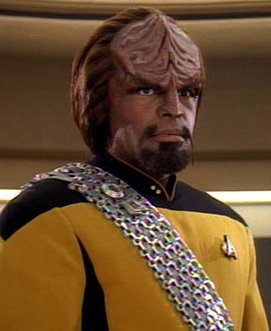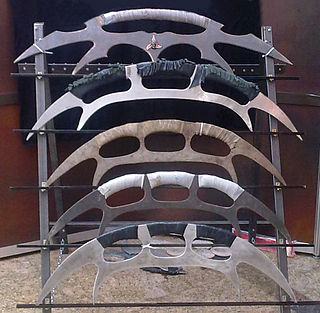
Worf, son of Mogh is a fictional character in the Star Trek franchise, portrayed by actor Michael Dorn. He appears in the television series Star Trek: The Next Generation (TNG), seasons four through seven of Star Trek: Deep Space Nine (DS9), and the third and final season of Star Trek: Picard, as well as the feature films Star Trek Generations (1994), Star Trek: First Contact (1996), Star Trek: Insurrection (1998), and Star Trek: Nemesis (2002).

Martok, son of Urthog is a recurring character in Star Trek: Deep Space Nine, played by actor J. G. Hertzler. Martok is a high-ranking Klingon leader at the Federation-Bajoran space station in the late 2300s. Martok figures prominently in many of the show's long running story arcs, and also is an important relationship for Worf.

Gowron, son of M'Rel, is a fictional character who appeared in the American science fiction television series Star Trek: The Next Generation and Star Trek: Deep Space Nine. Portrayed by Robert O'Reilly, he is the leader of the Klingon Empire, known as the Chancellor. O'Reilly had appeared earlier in The Next Generation as Scarface in the second season episode "Manhunt", and was cast as Gowron due to his comedic ability and his piercing and extremely unsettling gaze, or what O'Reilly himself humorously referred to as "that crazy loon eyeball thing".

Kahless "The Unforgettable" is a fictional character from the Star Trek media franchise. He was displayed as a portrait in Star Trek: The Original Series by Robert Herron and in Star Trek: The Next Generation by Kevin Conway; and is the titular character in the Star Trek novel Kahless by Michael Jan Freeman. Kahless is an important religious and historical figure to the Klingon race and has been studied in explorations of the philosophy within the setting of Star Trek.

The bat'leth is a double-sided scimitar/hook sword/lujiaodao hybrid-edged weapon with a curved blade, four points, and three handholds on the back. It was designed and created by Star Trek: The Next Generation visual effects producer Dan Curry for the Star Trek franchise, where it is the characteristic close combat weapon of Klingons. Curry has called the bat'leth "one of the iconic images associated with the show." It has spawned a smaller weapon, which became known as the mek'leth; in Klingon, this is written meqleH. A third weapon, a kur'leth, was later designed by Dan Curry, for Season 3 of Star Trek: Picard. Bat'leths have become an enduring symbol of the franchise among fans, and they are occasionally referenced in other media.
"Redemption" is a two-part episode of the American science fiction television series Star Trek: The Next Generation. Parts I and II of "Redemption" comprise the 100th and 101st episodes of the series, also being the fourth season finale and the fifth season premiere.
"Sins of the Father" is the 65th episode of the American science fiction television series Star Trek: The Next Generation and the 17th episode of the third season.
"Call to Arms" is the 26th and final episode of the fifth season of the science fiction television series Star Trek: Deep Space Nine, the 124th episode overall. This episode marks the start of the show's celebrated Dominion war story arc.
"Reunion" is the 81st episode of the syndicated American science fiction television series Star Trek: The Next Generation. It is the seventh episode of the fourth season.
"Once More unto the Breach" is the 157th episode of the television series Star Trek: Deep Space Nine, the seventh episode of the seventh season. This episode received a Nielsen rating of 4.5 when it was broadcast on television in 1998.
Rightful Heir is the 149th episode of the American science fiction television series Star Trek: The Next Generation, and the 23rd episode of the sixth season.
"Soldiers of the Empire" is the 119th episode of the television series Star Trek: Deep Space Nine, the 21st episode of the fifth season. It was directed by LeVar Burton.
"When it Rains..." is the 171st episode of the television series Star Trek: Deep Space Nine, the fifth of the final nine-episode arc of the series. This episode was directed by Michael Dorn and written by Rene Echevarria. It was first aired in broadcast syndication on May 3, 1999.
"Tacking Into the Wind" is the 172nd episode of the television series Star Trek: Deep Space Nine. The episode was written by Ronald D. Moore and directed by Mike Vejar.
"By Inferno's Light" is the 113th episode of the television series Star Trek: Deep Space Nine, the 15th episode of the fifth season.
Klingon culture is a set of customs and practices of Klingons depicted in the fictional Star Trek universe. The fictional Klingon society is based on Klingon traditions and conventions, as well as a constructed language named Klingon. Klingons were created by Gene L. Coon.
"Apocalypse Rising" is the 99th episode of the television series Star Trek: Deep Space Nine, the first episode of the fifth season. The episode was directed by James L. Conway, and written by Ira Steven Behr and Robert Hewitt Wolfe.
"The Way of the Warrior" is the first episode from the fourth season of the American syndicated science fiction television series Star Trek: Deep Space Nine, counting as the 73rd and the 74th episodes overall as it is a double-length episode. Michael Dorn joins the cast of Deep Space Nine as Worf, a character originating on the preceding series, Star Trek: The Next Generation.





